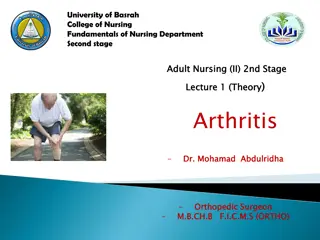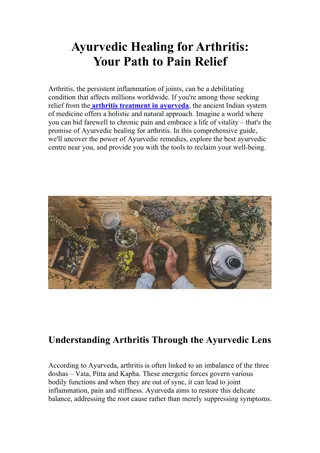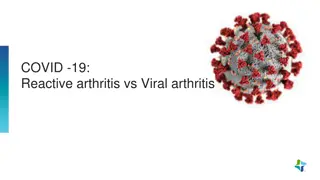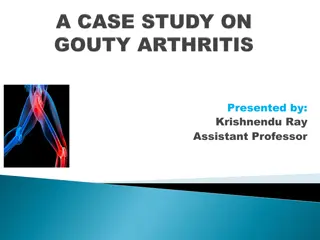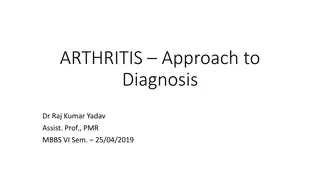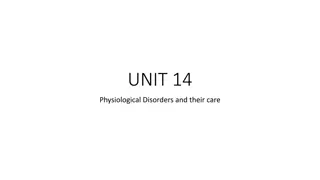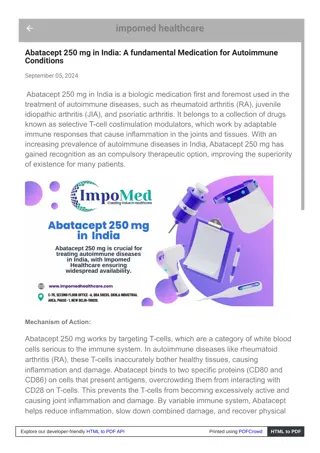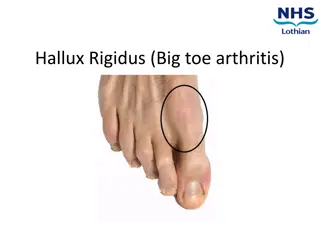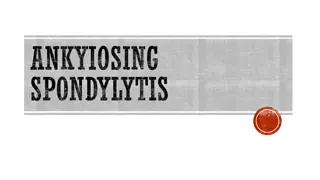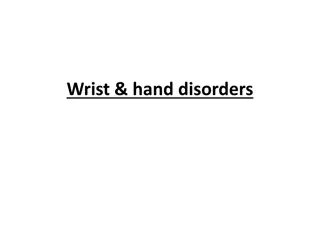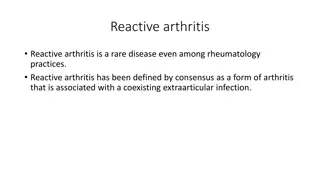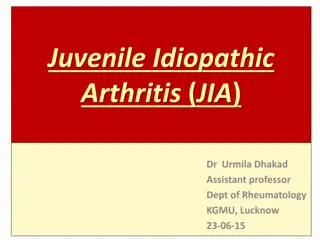Understanding Arthritis: Types, Causes, and Symptoms
Arthritis is inflammation of joints causing pain and limited function. It can be due to injury, metabolic abnormalities, hereditary factors, infections, or autoimmune conditions. Types include Osteoarthritis, Rheumatoid Arthritis, Gout, Ankylosing Spondylitis, Psoriatic Arthritis, and Reactive Arthritis, each affecting different joints. Symptoms include joint pain, swelling, stiffness, and warmth, typically starting in the upper extremities. Early detection and management are crucial for improved quality of life.
Download Presentation

Please find below an Image/Link to download the presentation.
The content on the website is provided AS IS for your information and personal use only. It may not be sold, licensed, or shared on other websites without obtaining consent from the author. Download presentation by click this link. If you encounter any issues during the download, it is possible that the publisher has removed the file from their server.
E N D
Presentation Transcript
Lecture# 16 semester# 2 Musculoskeletal System Disorders, Arthritis :by Assistant lecturers Sadiq Salam H. AL-Salih Hassanain Mohammed Khadim Kareem Waheed Mohammed Hussein Khadim Hussein Al-Mustaqbal University College Department of Nursing 2nd Class Adult Nursing
Arthritis Arthritis is inflammation of one or more joints.Symptoms of arthritis include pain and limited function of joints. Ajoint is an area of the body where two different bones meet. Arthritis is frequently accompanied by joint pain. Joint pain is referred to as arthralgia.
Causes of arthritis 1. Injury (leading to osteoarthritis). 2. Metabolic abnormalities (such as gout). 3. Hereditary factors. 4. The direct and indirect effect of infections (bacterial and viral) 5. Amisdirected immune system with autoimmunity (such as, systemic lupus erythematosus).
Types Of Arthritis: 1.Osteoarthritis is a painful, degenerative joint disease that often involves the hips, knees, neck, lower back, or small joints of the hands. OA usually develops in joints that are injured by repeated overuse from performing a particular task or playing a favorite sport or from carrying around excess body weight . 2.RheumatoidArthritis Is an autoimmune inflammatory disease that usually involves various joints in the fingers, thumbs, wrists, elbows, shoulders, knees, feet, and ankles. An autoimmune disease is one in which the body releases enzymes that attack its own healthy tissues. In RA, these enzymes destroy the linings of joints.
Cont.. 3.Gout (is caused by crystals that build up in the joints. It usually affectsthe big toe, but many other joints may be affected) 4.Ankylosing Spondylitis(is arthritis that affectsthe spine. It often involves redness, heat, swelling, and pain in the spine or in the joint where thebottom of the spine joins the pelvic bone.) 5.PsoriaticArthritis can occur in people who have psoriasis (scaly red and white skin patches). It affects the skin, joints, and areas where tissues attach to bone. 6.ReactiveArthritis is pain or swelling in a joint that is caused by an infection in your body.
Signs and Symptoms In general, the signs and symptoms can be divided into early and late manifestations. The typical pattern of joint inflammation is bilateral and symmetrical. The disease usually begins in the upper extremities and progresses to other joints over many years . Affected joints are slightly reddened, warm, swollen, stiff, and painful. The patient with RAoften has morning stiffness lasting for up to an hour, and those with severe disease may report experiencing stiffness all day. Generally, activity decreases pain and stiffness. Because of the systemic nature of RA, the patient may have a low-grade fever, malaise, depression, lymphadenopathy, weakness, fatigue, anorexia, and weight loss. As the disease worsens, major organs or body systems are affected. Joint deformities occur as a late symptom, and secondary osteoporosis (bone loss) can lead tofractures.
Diagnostic Tests No specific diagnostic test confirms RA.An increase in WBCs and platelets is typical. Immunological tests findings for patients with RAusually include thefollowing: 1. Presence of rheumatoid factor (RF) inserum 2. Decreased red blood cell (RBC) count 3. Decreased C4 complement 4. Increased erythrocyte sedimentation rate (ESR) 5. Positive antinuclear antibody (ANA) test 6. Positive C-reactive protein (CRP) test.
Management of arthritis 1.Physical therapy. 2.Splinting, cold-pack application. 3.Anti-inflammatory medications. 4.Pain medications 5.Immune-altering medications 6.Surgical operations (joint replacement). 7.Keep sugary and/or fatty foods to a minimum - such as red meat 8.Eating plenty of fruit and vegetables, as well as whole grains. 9. Omega-3 essential fatty acids are thought to relieve to some extent the symptoms of arthritis. 10.Maintain ideal body weight.
Nursing Diagnoses 1. Acute Pain relatedto chronicdisease process 2. Disturbed Body Image related to changes resultingfrom disease process 3. Fatigue relatedto chronicpain and limited mobility 4. Self-care Deficit relatedto chronic degenerative diseaseprocess 5. Impaired Physical Mobility related to chronicinflammation of joints
Nursing intervention 1. Assess pain; note the location and intensity (scale 0-10). Write downthe factors that accelerate and signs of pain non-verbal. 2. Instruct to frequently change positions.Helps to move inbed, prop a pain in the joints above and below, avoid jerky movements. 3. Instruct the patient to a warm bath or shower at the time awake. 4. Give a massage to enhance relaxation and reduce pain.
Cont.. 5. Encourage the use of stress management techniques, such as progressive relaxation 6. Give the drug prior to activity that is planned as directed to increase relaxation and to make it easier to participate in therapy. 7. Give anti-inflammatory and mild analgesic effect in reducing stiffness and increasing mobility. 8. Give the ice-cold compress if needed. That can relieve pain and swelling during the acute period.
Thanks For Listening


